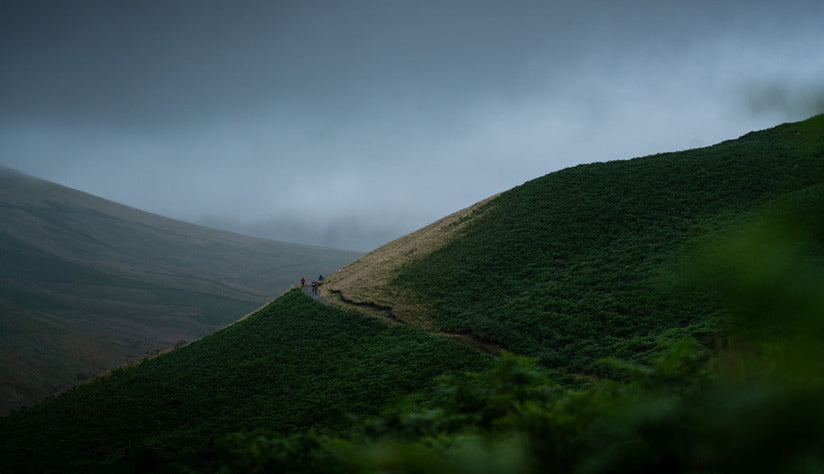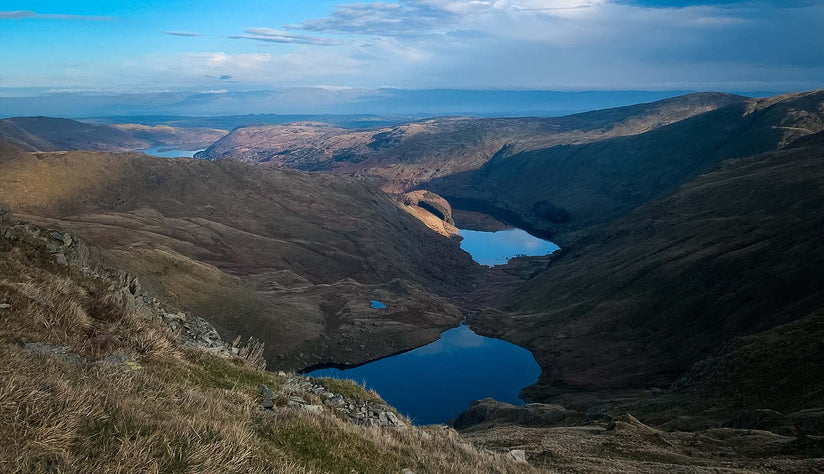Montane’s first race of the year is back and the iconic Montane Winter Spine Race never fails to remind us just how ferocious the Great British weather can be in the depths of winter. Based along the Pennine Way in the North of England, racers choose from 4 routes of varying lengths, the longest of which pans the entire 268-mile route from the Peak District, all the way to the Scottish Border
This non-stop footrace is not for the fainthearted and is the ultimate test of endurance for athletes in the new year. Those taking part will need to muster all their training and mental resilience to conquer the undulating terrain they will face along the way. Alongside hundreds of international participants towing the start line, we have 4 #TeamMontane athletes taking on the race this year. Hear from them to find out more, including their pre-race routines and advice for other eager runners…
Which Spine race are you taking on?
Simon: The Winter Spine Race is a 268-mile footrace along the Pennine Way in Winter. Nicknamed Britain’s Most Brutal Race, it’s a non-stop journey up the Spine of Britain. The terrain is unforgiving with mountains, rivers, rocks, mud, and peat bogs. When mixed with the winter weather, it’s one hell of a challenge.
Jon: The Challenger North, the northern section of the race. This covers 160 miles and starts in North Yorkshire, before heading up into the remote and exposed Cumbrian and Northumberland hills.
James: I’m doing the full Spine Race, so that's 268 miles from Edale in the Peak District to Kirk Yetholm on the Scottish borders. I’m looking forward to having a proper adventure for a few days and seeing what the body can do when pushed for such a long time and distance!
Tom: The Challenger North, so the last 160 miles of the Pennine Way. It is bleak and brutal in that section, and the furthest away from my usual training grounds. I can't wait.

What is the most brutal race you have taken on before this?
Simon: Any race ‘up north’ in winter is really hard. I guess Spine Race 2020 sticks out to me. Running a bit wild on the first stage cost me a knee injury, it was then a tough death march all the way up the Pennine Way. Lesson learnt there was to make sure you get through the first couple of stages in good health, to look after yourself and keep the body in check.
Jon: I think every race has its challenges that can make it tough and it depends on the conditions on the day. I’d probably say the Beyond the Ultimate Jungle multi-stage race with heat, humidity, altitude, river crossings, not being able to dry kit, and sleeping in hammocks. All this plus all sorts of wildlife in a very hostile environment.
James: I’ve debated this one before, whether it was the Dragon’s Back or the Northern Traverse. Both are very different. But I think as soon as you bring the continuous nature into play, you have more variables to try and control. So, based on this, I’d say the Northern Traverse - it was 180 miles from coast to coast. The sleep deprivation was exceptionally tough for the last 40 miles. Someone remind me why I signed up for the Spine?
Tom: I've done a couple of laps of the Barkley Marathons but got timed out rather than being done for. I need to go back there with better navigation skills. The hardest ultra I've done was a Wainwright's round in spring that was more like winter conditions, but that isn't a race. I would say the hardest race I've ever done still has to be the full Spine in winter.

How do you mentally prepare for a race like the Winter Spine?
Simon: Practice and experience come into play here. I don't think you can mentally prepare for tasks like this until you start doing them! Then you will know what mental challenges you will come up against. The more experience you have, then the more tools you develop. Enjoying what you're doing helps a lot, it's easy to quit a task if you're not having fun.
Jon: I think you need a level of fitness, but I don’t believe that dictates how well you do. Mentally showing up, pushing yourself in hard sessions, not quitting when it gets hard, getting out in all weather conditions, and becoming comfortable with being uncomfortable are massive. This builds resilience.
James: I agree with Jon. I’ve trained for the Spine race, almost exclusively, for a solid six months and this requires turning up, day after day, session after session. There have been plenty of times when the planned session seemed insurmountable, but lace up the shoes, get out the door, and it's amazing what you can achieve. Drawing on this bank of “micro resilience test wins” will hopefully stand me in good stead within the race.
Tom: I've got form at this distance and in these conditions so fundamentally I know what to do. That said, every time I go out for a run with the kit I learn something new about what works and what doesn't. That helps resilience on race day. As does thinking about things that might go wrong and planning for those in advance.

Tell us about your pre-race routine
Simon: Ha! Yeah, I'm a mess! I don't sleep the night before races, there's too much flowing through my mind. I've accepted this now, over the years of countless nights just pacing up and down a hotel room all night. The nights before a race are the longest! The hours before are just pure excitement, I'm just eager to get going!
Jon: I’m generally terrible pre-race. I’m never able to sleep and I can’t seem to switch my mind off. I’ll usually travel to the race the day before and register because otherwise, it means taking more time off work. I try to keep a routine with my diet and hydration, taking my breakfast with me for pre race etc…
James: I eat…a lot! Two hours or so before the race, I’m having a big breakfast. Then, usually 30 minutes from go-time, I’m having a top up, something like a banana. Other than that, my head will be getting in the game, getting focused, and ready to go. I really look forward to the start line - it's the end point of all the training. All the taping feet, shoulders, back etc… is done the night before.
Tom: There's the right answer here and then there is what actually happens. Work is busy so in all honesty im usually still packing kit up till the last minute and I then have a beer and watch some telly to try and switch my mind off so I can sleep….. on the rare occasions I have packed a week in advance and can then just chill for 48hrs before the race, this involves concentrating on sleep which has made a massive difference. Its definitely true that you can bank sleep. For the Swiss Peaks 360 in September I arrived in Switzerland 2 days before the race, with nothing to do but register and sleep. I then managed my shortest sleep interval ever having 3hrs total in a 99hr race.

What’s your Number 1 Spine Race packing essential?
Simon: I'm pretty excited about the Fireball Nano mid layer. They have nailed the amount of insulation in this jacket perfectly. It keeps you warm when running in the cold weather but the insulation is not so excessive so it keeps you cool when the racing gets hot! See my full kit list for the Winter Spine Race in this blog.
Jon: Waterpoof Jacket and Trousers. Essential for brutal weather - The Phase Pro Waterproof Jacket and Spirit Lite Trousers. Both are Gore Tex so block harsh winds, as well as providing brilliant water protection.
James: This one is difficult, so I’m going with three 😂. The Phase XPD Waterproof Jacket is a very hardcore waterproof and will be essential on the Spine (paired up with the Spirit Lite Trousers). Then there are the gloves (I’m opting for the Switch Mitts and the Alpine Resolve Gloves if things get very cold). And finally, the Slipstream Trail Tights - these are very comfy, dry quickly, and fit nicely under all the waterproofs!
Tom: All the Montane waterproofs are excellent. With winters getting warmer, but the rain never getting less I have a preference to pack 2 lightweight pairs and if it gets gnarly, double them up rather than taking 1 heavy-weight pair. I've seen many a hole in waterproofs on the Spine before, but even in the most lightweight range, I've never had a problem with Montane. My 1 best item to complement my waterproofs is a Waterproof Hat. My head and ears are warm and even when the rain, sleet, or snow is coming sideways, it stays out of my eyes.
Top piece of running advice
Simon: Don't worry! Don't let your thoughts get the better of you. Just get to that start line and go for it. You're going to have an unforgettable journey and memories that will last forever. Get stuck into it..and smile
Jon: Run your own race, don’t let others around you dictate your pace. These races are long so there’s plenty of time, so concentrate on yourself.
James: Break it down. The Spine is 10 marathons, 134 two-mile runs, and a 268-mile long run. Depending on how things are going, completing a marathon might be a big milestone, or simply getting another mile bagged might be the only progress indicator that matters at that point in time. One foot in front of the other. For me personally, it always helps to get past that big halfway marker too!
Tom: Forget grams of carbohydrate per hour. You will need protein and fat and if you are out long enough, and vitamins and minerals. Most importantly you will need things you like to eat. After 24 hours I find my body craves proper food and increasingly rejects sugars. Starting with savoury as well as sugars really helps to regulate this, as does taking sweet stuff with a spice hit e.g. cinnamon or ginger. I also use this as a form of pacing at the start. Am I moving slowly enough that I could eat a pasty? If not, I need to slow down.
The first Montane Winter Spine Race 2024 kicks off on the 13th of January, keep up with all the action on our official Winter Spine Race HUB.















